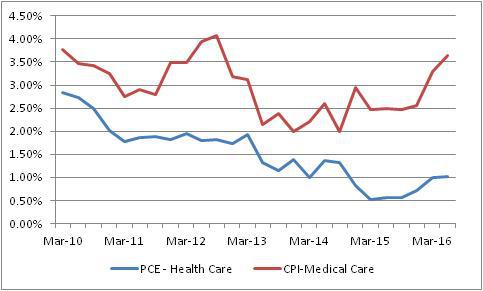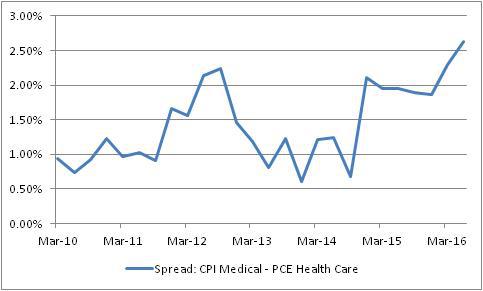On Friday, I was on Bloomberg TV’s “What’d You Miss?” program to talk about the PCE inflation report from Friday morning. You can see most of the interview here.
I like the segment – Scarlet Fu, Oliver Renick, and Julie Hyman asked good questions – but we had to compress a fairly technical discussion into only 5 or 6 minutes. As a result, the segment might be a little “wonky” for some people, and I thought it might be helpful to present and expand the discussion here.
The PCE report itself was not surprising. Core PCE came in as-expected, at 1.7%. This is rising, but remains below the Fed’s 2% target for that index. I think it is interesting to look at how PCE differs from CPI to see why PCE remains below 2%. After all, core PCE is the only inflation index that is still below 2% (see chart, source Bloomberg). And, as we will see, this raises other questions about whether PCE is a reasonable target for Fed policy.

There are several differences between CPI and PCE, but the main reasons they differ can be summarized simply: the CPI measures what the consumer buys, out-of-pocket; the PCE measures not only household expenditures but also spending on behalf of consumers, including such things as employer-purchased insurance and some important government expenditures. As pointed out by the BEA on this helpful page, “the CPI is based on a survey of what households are buying; the PCE is based on surveys of what businesses are selling.”
This leads to two major types of differences: weight effects and scope effects.
Weight effects occur because the PCE is a broader index covering more economic activity. Consider housing, which is one of the more steady components of CPI. Primary rents and owners’-equivalent rent constitute together some 32% of the CPI and those two components have been rising at a blended rate of about 3.4% recently. However, the weight of rent-of-shelter in PCE is only 15.5%. This difference accounts for roughly half of the difference between core CPI and core PCE, and is persistent at the moment because of the strength in housing inflation.
However, more intriguing are the “scope” differences. These arise because certain products and services aren’t only bought in different quantities compared to what businesses sell (like in the case of housing), but because the two surveys include and exclude different items in the same categories. So, certain items are said to be “in scope” for CPI but “out of scope” for PCE, and vice-versa. One of the places this is most important is in the category of health care.
Most medical care is not paid for out-of-pocket by the consumer, and therefore is excluded from the CPI. For most people, medical care is paid for by insurance, which insurance is usually at least partly paid for by their employer. Also, the Federal government through Medicare and Medicaid provides a large quantity of medical care goods and services that are different from what consumers buy directly – at least, purchased at different prices than those available to consumers!).
This scope difference is enormously important, and over time accounts for much of the systematic difference between core CPI and core PCE. The chart below (source: BEA, BLS) illustrates that Health Care inflation in the PCE essentially always is lower than Medical Care inflation in the CPI.

Moreover, thanks in part to Obamacare the divergence between the medical care that the government buys and the medical care consumers buy directly has been widening. The following chart shows the spread between the two lines above:

It is important to realize that this is not coincidental, but likely causal. It is because Medicare and other ACA control structures are restraining prices in certain areas (and paid by certain parties) that prices to the consumer are rising more rapidly. Thus, while all of these inflation measures are likely to continue higher, the spread between core CPI and core PCE is probably going to stay wider than normal for a while.
Now we get to the most interesting question of all. Why do we care about PCE in the first place? We care because the Fed uses core PCE as a policy target, rather than the CPI (despite the fact that it has ways to measure market CPI expectations, but no way to measure PCE expectations). They do so because the PCE covers a wider swath of the economy. To the Fed, this means the PCE is more useful as a broader measure.
But hang on! The extra parts that PCE covers are, substantially, in parts of the economy which are not competitive. Medicare-bought prices are determined, at least in the medium-term, by government fiat. The free market does not operate where the government treads in this way. The more-poignant implication is that there is no reason to suspect that these prices would respond to monetary policy! Ergo, it seems crazy to focus on PCE, rather than CPI (or one of the many more-useful flavors of CPI), when setting monetary policy. This is one case where I think the Fed isn’t being malicious; they’re just not being thoughtful enough.
Every “core” inflation indicator, including the ones above (and you can throw in wages and the Employment Cost Index as well!), is at or above the Fed’s target even accounting for the typical spread between the CPI and PCE. Not only that, they are above the target and rising. The Fed is most definitely “behind the curve.” Now, as I have noted before in this space I don’t think there’s anything the Fed can do about it, as raising rates without restraining reserves will only serve to accelerate inflation further since it will not entail a slowing of money supply growth. But it seems to me that, for starters, monetary policymakers should focus on indices that are at least in principle (and in normal times) more responsive to monetary policy!
